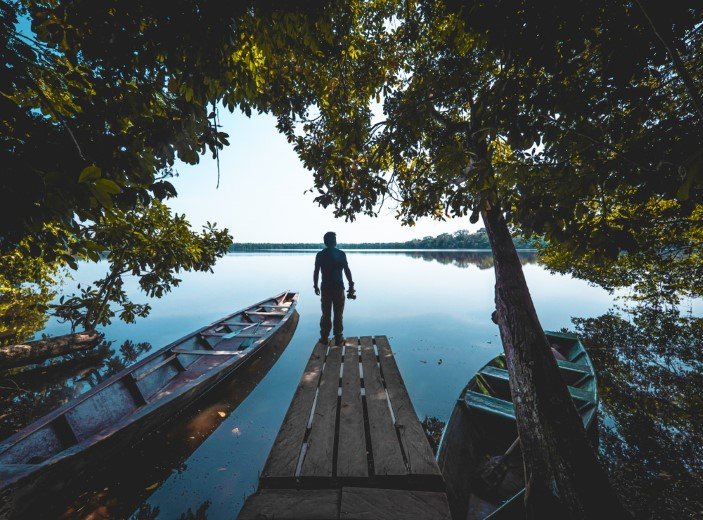If you’re considering a trip to the Tambopata National Reserve in February, it’s important to know what to expect from this incredible natural destination. This protected area of over 270,000 hectares in the Peruvian Amazon is home to jaguars, howler monkeys, macaws, and thousands of bird and butterfly species. In February, the Tambopata National Reserve is in the middle of the rainy season, which makes the jungle appear greener and more alive than ever, with flooded rivers and oxbow lakes. However, the humid climate brings special challenges. Below, we share the main advantages and disadvantages of visiting Tambopata in February, along with weather details, activities, and practical tips to help you prepare.
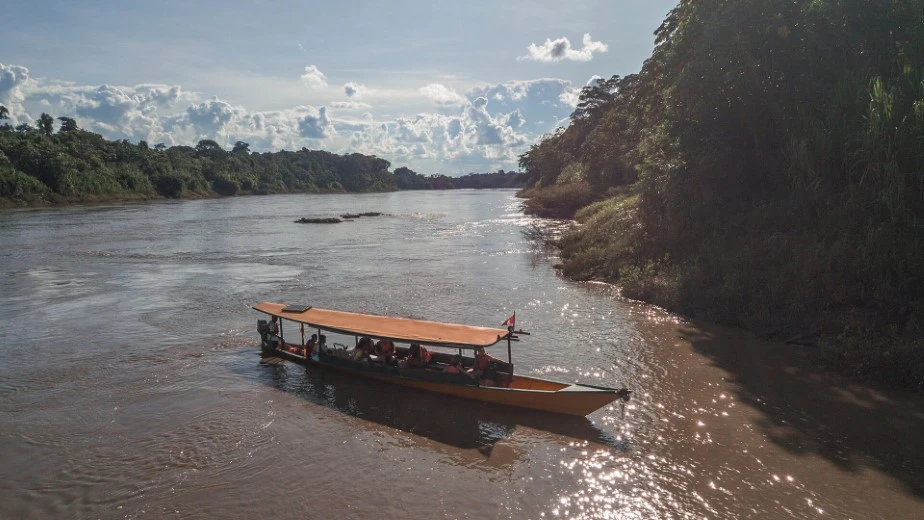
Advantages of visiting Tambopata National Reserve in February
- Denser jungle: Heavy rains transform the forest into vibrant green landscapes, ideal for photographers and nature lovers.
- Increased wildlife activity: During the rainy season, many species are more active. In February, macaws are nesting and are highly visible at the clay licks. It’s also a good time to see monkeys, toucans, butterflies, and flowering plants.
- Fewer tourists: February is low season. You’ll find fewer visitors, which means a quieter and more authentic experience. Fewer people on trails and viewpoints allow for a better connection with nature.
- Cooler weather: Although it rains, temperatures are usually slightly lower. Days are warm (max. 82°F / 28°C), but the rain cools the air.
- Access to remote areas: The rivers rise, opening new navigable routes. You can explore canals and lakes that are inaccessible during the dry season. This allows, for example, canoe tours into the deep jungle and closer encounters with aquatic wildlife in their natural habitat.
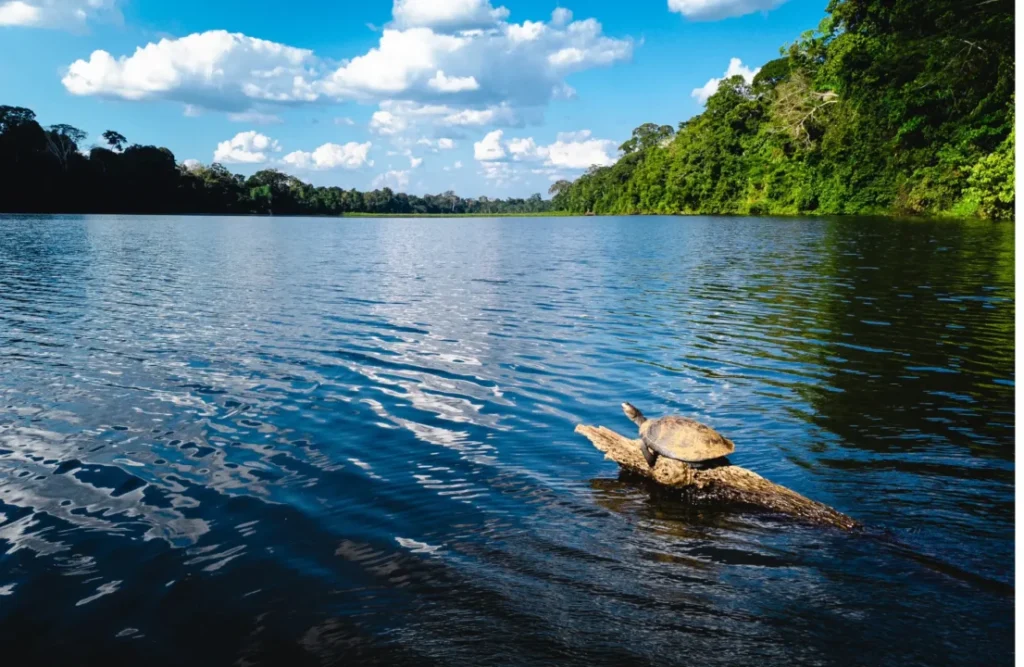
Disadvantages of visiting Tambopata National Reserve in February
- Frequent rain: February is the rainiest month. Showers can interrupt hikes or boat rides, and sometimes activities must be temporarily suspended.
- Muddy trails: Jungle paths become very muddy and slippery. Trekking tours require more physical effort and proper footwear.
- Mosquitoes and humid heat: The high humidity creates a perfect environment for insects. In February, there are more mosquitoes and bites than in the dry season, so preventive care is essential.
- Vulnerable equipment: Humidity can damage electronics and clothes. It’s crucial to protect cameras and documents from water.
- Slower travel: Access roads may be flooded, increasing travel time to Puerto Maldonado, the starting point for reaching the reserve.
Activities in Tambopata National Reserve in February
- Boat ride on the Madre de Dios River: Spotting turtles, caimans, birds, and butterflies.
- Visit to Monkey Island: Observation of various monkey species, including a hybrid species.
- Jungle hike: Two-hour trek through the tropical forest, observing medicinal plants, century-old trees, monkeys, and parrots.
- Search for nocturnal animals: Boat ride on the river to spot nocturnal wildlife like porcupines, sloths, arachnids, insects, opossums, and owls.
- Exploration of Lake Sandoval: 3 km walk and boat ride to observe caimans, giant otters, herons, turtles, and monkeys.
- Visit to a local farm: Learn about grafting techniques and soils, with tastings of typical jungle products.
- Hike to a 700-year-old tree: Trail and hanging bridges to observe canopy wildlife.
- Night walk in the jungle: Ecological trek to spot nocturnal fauna and see the Milky Way.
- Boat ride on the Tambopata River: Sightings of jaguars, anacondas, and other animals in their natural habitat.
- Visit to Chuncho Clay Lick: Observation of macaws and parrots feeding on mineral-rich clay.
- Exploration of Lake Yacumama: Boat ride to spot black caimans, herons, cormorants, wild ducks, and river otters.
- Walk on the 3 km wooden trail at Lake Sandoval: Observation of black caimans, giant otters, herons, turtles, and monkeys.
- Boat tour on Lake Sandoval: Explore the lake’s biodiversity.
- Interaction with the Matsigenka community: Learn about their customs, such as archery, cotton spinning, and fire-making techniques.

Weather in Tambopata National Reserve in February
- Temperatures: Between 73°F and 82°F (23°C and 28°C). Warm days and humid nights.
- High humidity: Exceeds 80% almost daily.
- Frequent rain: February is the rainiest month of the year. There’s a high chance of daily rain, though it usually doesn’t rain all day.
- Cloudy days: Partially overcast skies, with good diffused light for photography.
- High water levels: Rivers rise and flood lowland forests, making boat routes accessible, but limiting some walking trails.
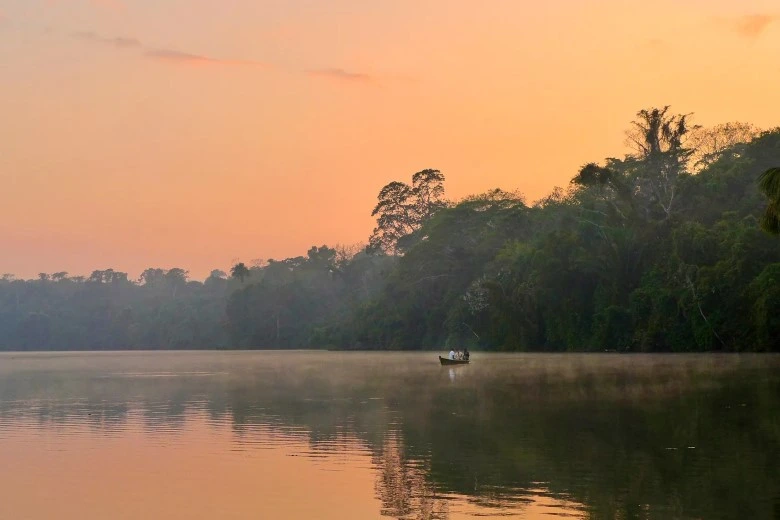
Tips for traveling to Tambopata National Reserve
- Vaccines and health: The yellow fever vaccine is recommended. Bring a basic first-aid kit, strong insect repellent, and bite cream.
- Proper clothing: Wear light, quick-dry, long-sleeve clothing. Bring a raincoat or poncho, swimsuit, and a sweater for the evenings.
- Appropriate footwear: Waterproof boots for hikes and comfortable sandals for the lodge.
- Sun protection: Despite the rain, the tropical sun burns. Bring a cap, sunscreen, and sunglasses.
- Photography gear: Cameras with zoom lens, waterproof covers, extra batteries, and binoculars.
- Headlamp: Essential for night walks and areas without electricity.
- Light luggage: Use a durable backpack, sealed plastic bags, and keep the weight light (10–15 kg).
- Documents and cash: Bring a passport copy and cash in soles.
- Reservations and guides: Book tours in advance. Use of authorized guides is mandatory.
- Special recommendation: Peru Jungle Trips is a specialized and reliable agency, focused on wildlife photography.
Frequently Asked Questions about Tambopata National Reserve in February
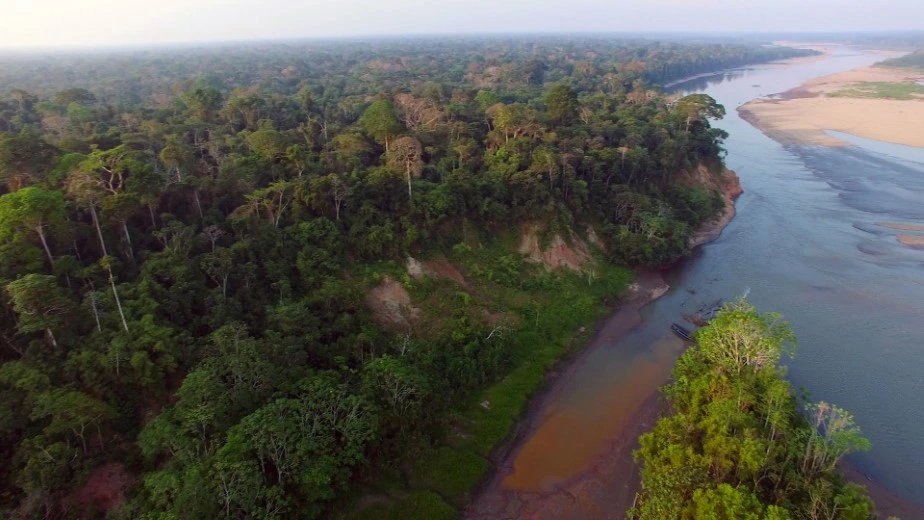
1. How many days should I plan to visit Tambopata National Reserve?
Ideally, you should stay between 3 to 5 days to enjoy the main excursions such as hiking, viewpoints, macaw clay licks, and lakes. If you stay for less time, you might not be able to explore fully, while more days allow for a more relaxed experience in the rainforest.
2. Do I need a guide to enter Tambopata National Reserve?
Yes, the regulations of the reserve require you to hire a certified local guide. Never attempt to enter on your own, as guides know the trails, ensure your safety, and make it easier to spot wildlife in Tambopata National Reserve.
3. What wildlife is commonly seen in Tambopata National Reserve in February?
February is excellent for spotting macaws, toucans, monkeys (such as spider monkeys, capuchins, and howler monkeys), caimans, giant otters, and capybaras. You can also see water birds, fish, and colorful frogs. Although jaguars are elusive, some tourists report paw prints or hearing them at night. Due to the lower number of visitors, there are more chances to see wildlife up close in Tambopata National Reserve.
4. Does it rain all day in Tambopata National Reserve in February?
No, it doesn’t rain all day, even though February is very rainy. Showers are intermittent, and sometimes it only rains in the afternoon. While it’s the rainiest month, it rarely rains continuously all day in Tambopata National Reserve, so it’s important to be prepared to get wet at some point.
5. What clothing and gear should I bring to Tambopata National Reserve in February?
It’s recommended to bring quick-drying clothes, preferably long sleeves and long pants. Don’t forget a raincoat or poncho, rubber or trekking boots, extra dry socks, and a sturdy umbrella. Also bring sunscreen, insect repellent, a hat, a headlamp, and protect your camera with a waterproof case. A small backpack will be useful to carry water and other essentials while exploring Tambopata National Reserve.
6. Is it safe to travel to Tambopata National Reserve during the rainy season?
Yes, it is safe, but with certain precautions. Guides and lodges in Tambopata National Reserve are used to operating year-round. To avoid risks, wear non-slip footwear, avoid flooded paths, and always stay with the group. The main risk is bad weather, such as slippery conditions and the presence of mosquitoes. Also, since it’s low season, there are usually fewer tourists, which allows for a quieter and more personalized experience.
7. What must-do activities are available in Tambopata National Reserve in February?
Top activities include visiting the Chuncho Macaw Clay Lick at dawn, boating on Lake Sandoval and exploring oxbow lakes by canoe, hiking through highland rainforest, and climbing the Canopy Tower for panoramic jungle views. Night walks along the Tambopata River beach are also recommended to spot caimans and nocturnal wildlife. Don’t forget your camera and binoculars, as February is an excellent month for nature photography in Tambopata National Reserve.
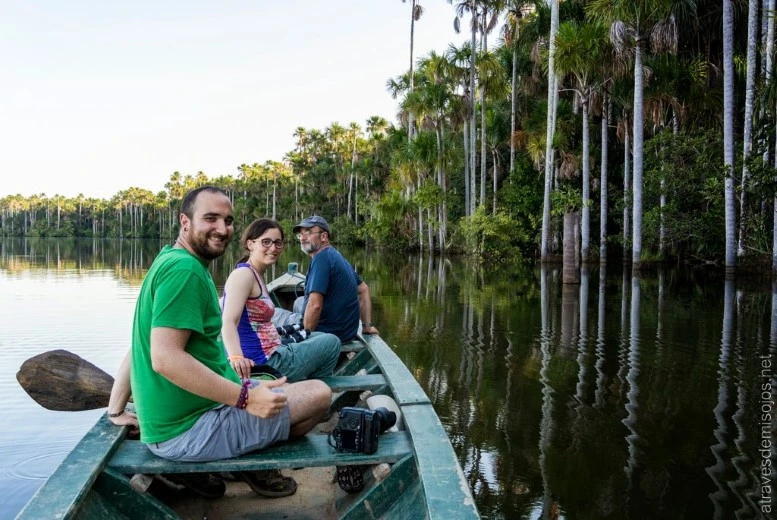
In February, Tambopata National Reserve is in the peak of the rainy season, and the rainforest is highly active with wildlife. While there is more rain, there are fewer tourists and special boat routes. It’s recommended to prepare for humid weather and bring appropriate clothing and waterproof gear. Activities include boat rides, jungle treks, and nocturnal wildlife spotting. Contact us and book your trip to Tambopata National Reserve.
Tours to Tambopata National Reserve
- Lake Sandoval (2 Days)
- Tambopata Jungle Tour (3 Days)
- Sandoval Lake + Parrot clay lick + Native Community (4 days)
- Collpa Chuncho Macaw Clay Lick + Sandoval Lake & Yacumama Lake (4 Days)
Related Articles about Tambopata National Reserve
- Photography Tour in Tambopata National Reserve in January: Pros and Cons
- Tambopata National Reserve in March: Weather, Pros and Cons of Visiting the Peruvian Jungle

